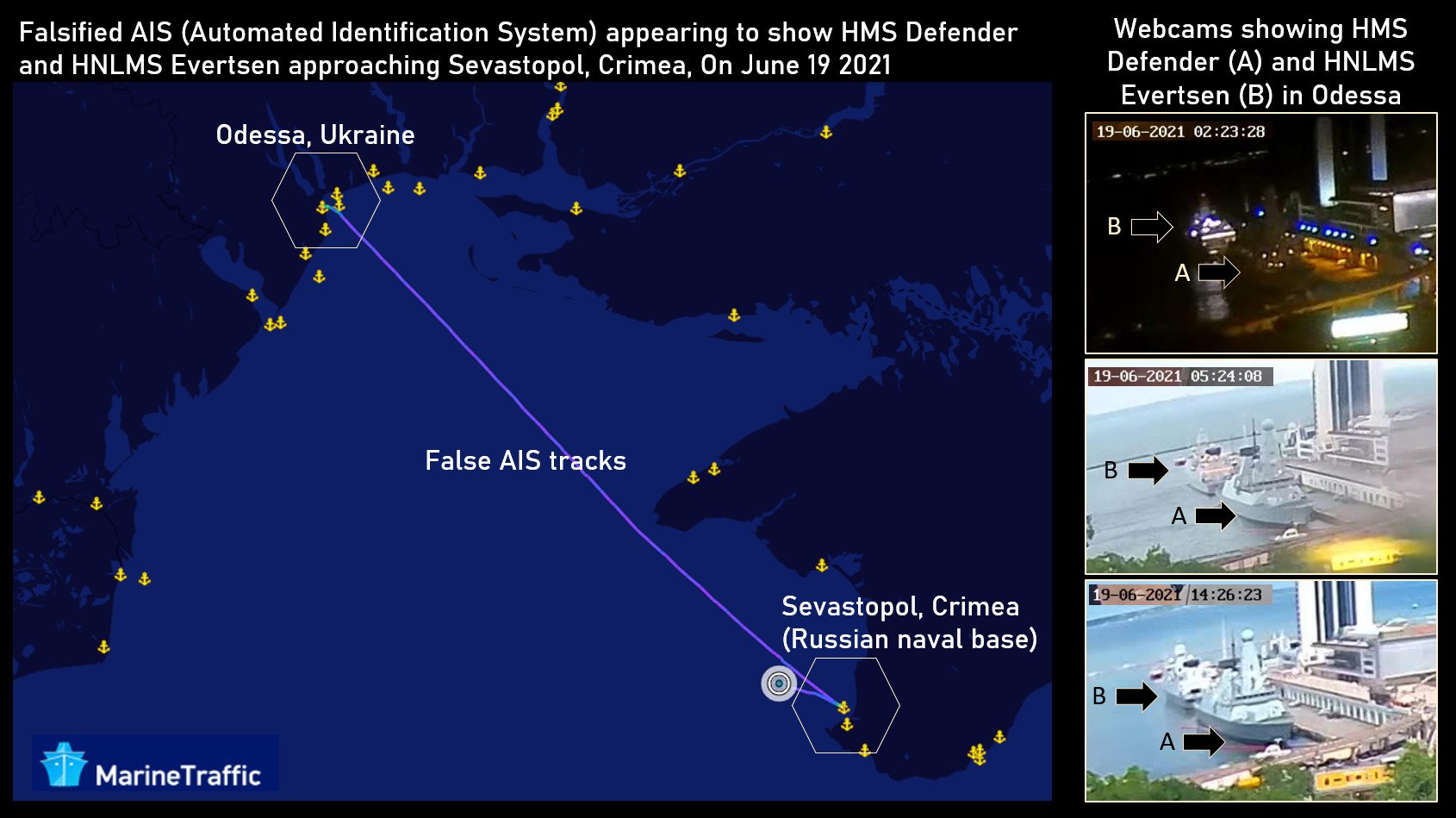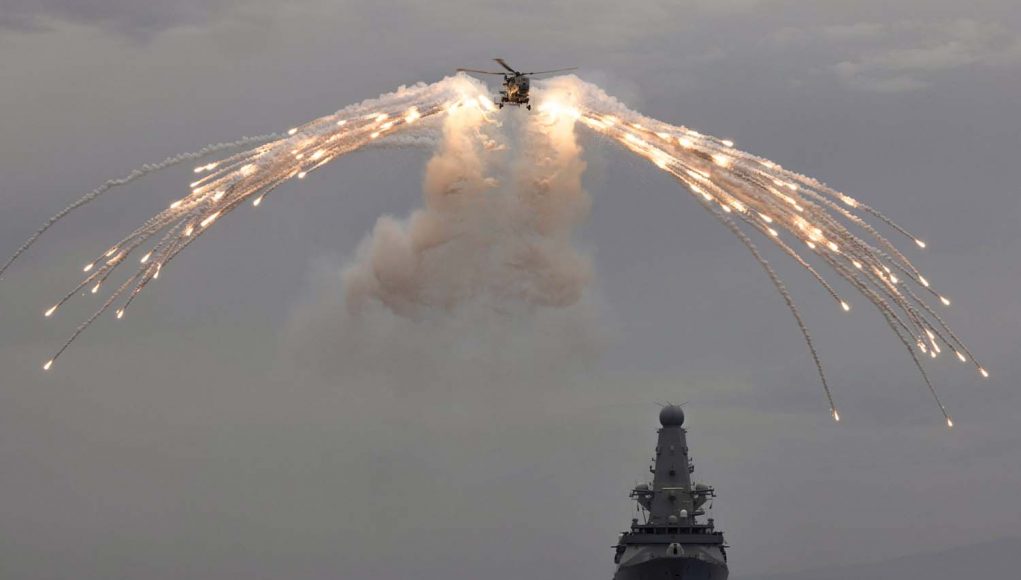Fortele navale ale Federatiei Ruse, care ocupa in mod ilegal Crimeea, au tras focuri de arma si au lansat bombe asupra unei nave NATO care se afla in apele teritoriale ale Ucrainei, anunta ministerul rus al apararii.
HMS Defender, nava militara a Marii Britanii, se afla in mars de intoarcere din Ucraina, unde participase la exercitii cu marina ucraineana.
Ministerul apararii din Federatia Rusa pretinde ca HMS Defender a intrat in apele teritoriale rusesti, la mai putin de 12 mile marine de tarmul Crimeei, anexata ilegal de Rusia. Drept pentru care ar fi fost lansate focuri de avertisment si bombe.
Iata si reactia Ministerului Britanic al Apararii :
Ministry of Defence Press Office@DefenceHQPress
No warning shots have been fired at HMS Defender. The Royal Navy ship is conducting innocent passage through Ukrainian territorial waters in accordance with international law.
We believe the Russians were undertaking a gunnery exercise in the Black Sea and provided the maritime community with prior-warning of their activity. No shots were directed at HMS Defender and we do not recognise the claim that bombs were dropped in her path.
Iata ce spune agentia TASS preluata de Agerpres :
O navă militară rusă a tras focuri de avertisment asupra distrugătorului HMS Defender al Marinei Regale britanice după ce acesta a intrat în apele ruseşti din Marea Neagră, iar un avion rusesc a lansat bombe în calea sa, a declarat miercuri Ministerul rus al Apărării, citat de TASS.
Defender a părăsit apele ruseşti la scurt timp, după ce înaintase până la 3 kilometri în interiorul acestora, a adăugat ministerul rus. ”Distrugătorul a fost avertizat că va fi folosit armamentul dacă trece graniţa Federaţiei Ruse. El nu a reacţionat la avertisment”, mai menţionează acelaşi minister. De asemenea potrivit acestuia, un avion rus de bombardament a lansat în calea distrugătorului britanic patru bombe înalt explozive cu fragmentaţie, ca avertisment.
Detalii foarte pretioase din Moscow Times : Institutul Naval al SUA (USNI) dezvaluie faptul ca in urma cu 2 zile, nava HMS Defender a facut obiectul unui fake de proportii prin raportarea gresita (diferita) a pozitiei sale reale de mars in Marea Neagra. Falsul traseu arata pe harta ca nava NATO s-ar indrepta spre sediul Flotei Ruse la Marea Neagra din Sevastopol !
The U.S. Naval Institute’s news website had reported Monday that HMS Defender’s and another NATO warship’s open-source intelligence data was faked to make it appear as if they sailed directly to the headquarters of Russia’s Black Sea Fleet.
“Positioning two NATO warships at the entrance of a major Russian naval base would be widely seen as a provocative action, based on conflicting claims of sovereignty,” USNI News wrote.
Most countries still recognize Crimea, which Moscow annexed in 2014, as part of Ukraine.
Rob Lee, a doctoral student who follows Russian deployments at King’s College London’s war studies department, told The Moscow Times that Russia’s use of warning shots on a NATO vessel would mark a “new” development.
“[Russia has] conducted some very aggressive naval and aerial intercepts, but this would be new. And certainly a much bigger deal than normal aggressive intercepts. I’m wary of saying unprecedented, but I can’t remember this happening as long as I have been following this,” Lee said.
“HMS Defender’s mission to the Black Sea was a political one — about projecting presence, supporting Kiev and reminding Moscow that its annexation was not forgotten or accepted,” tweeted Mark Galeotti, a senior associate fellow at the Royal United Services Institute and expert on Russian security affairs.
“Moscow likewise reacted politically (in its own way), first spoofing GPS signals to try and present Defender and a Dutch frigate as aggressively heading straight for the Russian Black Sea Fleet base at Sevastopol… and now claiming — as they have in the past — to have ‘driven’ the Royal Navy away by aggressive operations,” he added.
Anexarea ilegala a Crimeei a condus la extinderea controlului Rusiei asupra apelor teritoriale ucrainiene. Nici o institutie internationala nu recunoaste anexarea ilegala sau consecintele ce decurg de aici. Navele NATO care exerseaza de ani de zile impreuna cu riveranele aliate de la Marea Neagra (Turcia, Romania, Bulgaria) au facut obiectul unor provocari si agresiuni relatate pe larg de presa internationala.
Statele partenere NATO – Ucraina si Georgia – au fost invadate militar de Rusia in 2014, respectiv 2008. Pe teritoriul Ucrainei, in Donbas, Rusia alimenteaza un razboi de ocupatie care a generat pana in prezent 13.000 de morti.
HMS Defender has completed NATO security operations in the Mediterranean and will be heading to the Black Sea after a stop in Istanbul.
The Type 45 destroyer is part of the UK’s Carrier Strike Group but has peeled away from the task group temporarily to carry out her own set of missions in the Black Sea.
Over the past few weeks Portsmouth-based Defender completed intensive training and worked on Operation Sea Guardian, NATO’s mission in the Mediterranean to deter and counter terrorism.
Defender is now in Istanbul with Dutch frigate HNLMS Evertsen – which is also part of the Carrier Strike Group – and will be hosting representatives from the Turkish government, business world, armed forces and defence sector during her stay there.
Commanding Officer, Commander Vincent Owen said: “After over 12 months of preparations with the added challenges of COVID-19, it is fantastic to have sailed and started deployment as part of the UK Carrier Strike Group.
“These first weeks as we have worked with NATO on Operation Sea Guardian in the Mediterranean has shown what a superb asset the Type 45 destroyer is and in particular the ability of the highly-trained men and women we have on board to be able to achieve a range of tasks at short notice.
“We are all very proud to be part of this milestone deployment showcasing Global Britain and the UK Carrier Strike capability, we are ready for whatever tasking we are called to deliver.”
Defender’s deployment so far has been mainly focused on her work in the Carrier Strike Group, in which she forms part of the ‘ring of steel’ – including frigates, submarines, Royal Marines, Royal Fleet Auxiliary ships and aircraft – around carrier HMS Queen Elizabeth on her maiden operational deployment.
%20%%3E)
After hitting heavy weather crossing of the Bay of Biscay, Defender’s ship’s company carried out a number of training drills to test their responses, including man overboard exercises and firing of the 50 calibre heavy machine gun.
Defender then sailed through the Messina Strait – between Sicily and the Italian mainland – before the embarked 815 Naval Air Squadron Wildcat helicopter simulated a crash on deck.
Overseen by the Flight Commander, Lieutenant Mark Finnie, sailors helped in firefighting, first aid, treatment and casualty extraction as the mock crash unfolded.
He said: “Safety critical exercises like this prove the ship’s efficiency to work as a coherent team in difficult situations and find solutions to sometimes taxing problems. The scenario here which was a simulated helicopter crash, takes everyone on board to assist.”
After a month at sea, Defender then stopped off in Crete, heading for NATO’s Forces Sensor and Weapon Accuracy Check Site, which is used for calibration of sensors, weapons, communications and navigation systems.
Sailors and Royal Marines of HMS Defender’s boarding team also headed for the NATO Maritime Interdiction Operations Training Centre at Souda Bay Naval Base, where they refreshed some key skills.
Defender’s boarding officer Lieutenant Cameron Osborn Royal Navy, said: “The four days using the extensive experience and excellent facilities at the NATO MIOTC were very useful consolidation training.
“It allowed our Royal Navy and Royal Marine boarding teams to build on their own training in a realistic environment to make sure we are fully prepared if we are required to board vessels during deployment.”
#Defender, #BlackSea, #NATO, #Ukraine, #Russia, #incident
Iata pozitia US Naval Institute despre falsul facut pe tema traselului HMS Defender
Positions of Two NATO Ships Were Falsified Near Russian Black Sea Naval Base
By: H I Sutton
June 21, 2021 2:36 PM

USNI News Illustration
The tracking data of two NATO warships was faked off the coast of a Russian controlled naval base in the Black Sea while the actual ships were moored 180 miles away, USNI News has learned.The U.K. Royal Navy’s HMS Defender, a Type-45 Daring-class destroyer, and the Royal Netherlands Navy’s HNLMS Evertsen, a De Zeven Provinciën-class frigate, pulled into Odessa in Ukraine on June 18. The group had been monitored by Russian warships while exercising in the Black Sea, according to U.S. Navy photos dated on June 17.
According to an automatic identification system (AIS) signal, which transmits position details to improve maritime safety, the pair left Odessa just before midnight on June 18. The data shows that they sailed directly to Sevastopol, approaching to within two nautical miles of the harbor entrance. The strategic port houses the headquarters of Russia’s Black Sea fleet.
Despite the AIS track, there is clear evidence that the two warships did not leave Odessa. Live webcam feeds show that they did not leave Odessa, however. This was anyway the known situation in defense circles, and local media. Anyone in Odessa can see that they did not leave. The webcams are broadcast live on YouTube by Odessa Online. Screenshots archived by third party weather sites like Windy.com show the two warships present in Odessa overnight.
Positioning two NATO warships at the entrance at the entrance of a major Russian naval base would be widely seen as a provocative action, based on conflicting claims of sovereignty . Most of the international community, including the U.S, Britain and the Netherlands, do not recognize Crimea as part of Russia.
U.K. Royal Navy destroyer HMS Defender, USS Laboon and Dutch frigate HMNLS Evertsen take station for close proximity sailing as a Russian warship watches from afar (rear of picture) in the Black Sea on June 17, 2021. US Navy Photo
While the motives for the deception are unclear, the move raises questions about the efficacy of open-source intelligence data, such as AIS, which is becoming more common in both defense and by journalists. There is compelling evidence that the AIS tracks were faked. NATO representatives did not immediately respond to requests for comment and the tracks were confirmed as false by Dutch naval warfare news site Marineschepen.nl.
The AIS positions were shared with AIS aggregator MarineTraffic.com by a receiver station in Chornomorsk, close to Odessa. Other AIS aggregators also reported the false positions. HMS Defender was shown under the credentials that she is currently using, IMO 4907878. HNLMS Evertsen was reported as “Netherlands Warship,” MMSI 244942000. It is unclear how the false AIS data was introduced to the feed.
Both Defender and Evertsen are part of CSG21, the carrier strike group centered around HMS Queen Elizabeth (R08). The main body of CSG21 has remained in the Mediterranean, while the two warships temporarily deployed to the Black Sea, where they have been performing freedom of navigation missions and exercising with allies. They have visited Turkey and Ukraine and will also exercise with Romania and Georgia. They have also met with the U.S. Navy’s Arleigh Burke-class destroyer USS Laboon (DDG-58).




